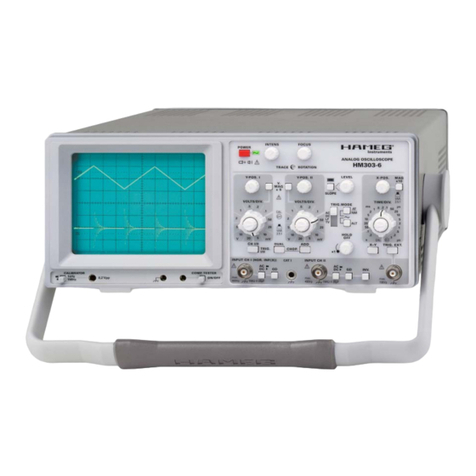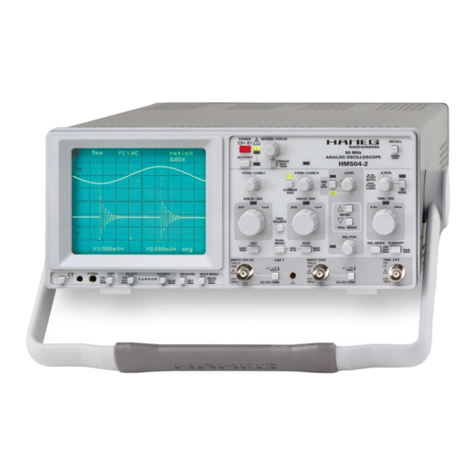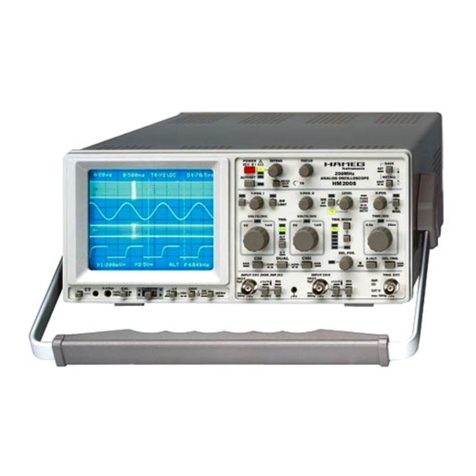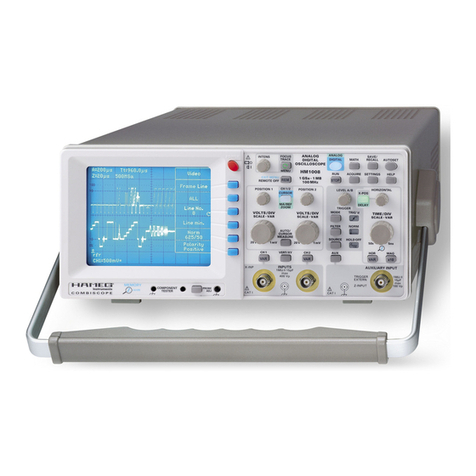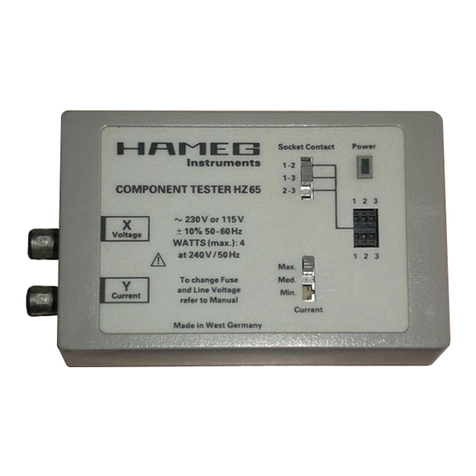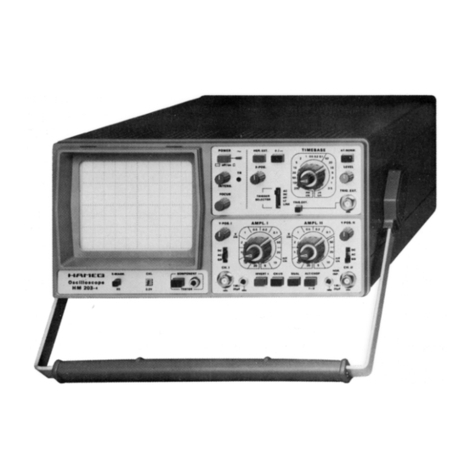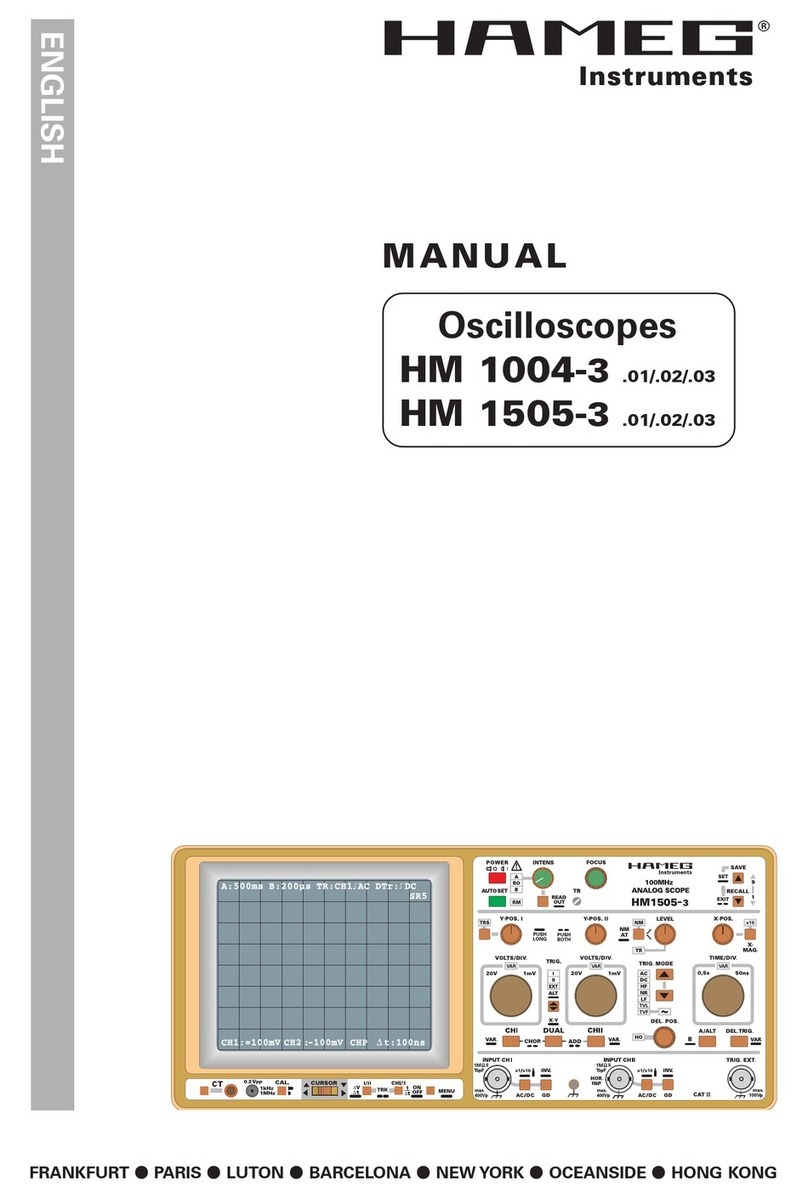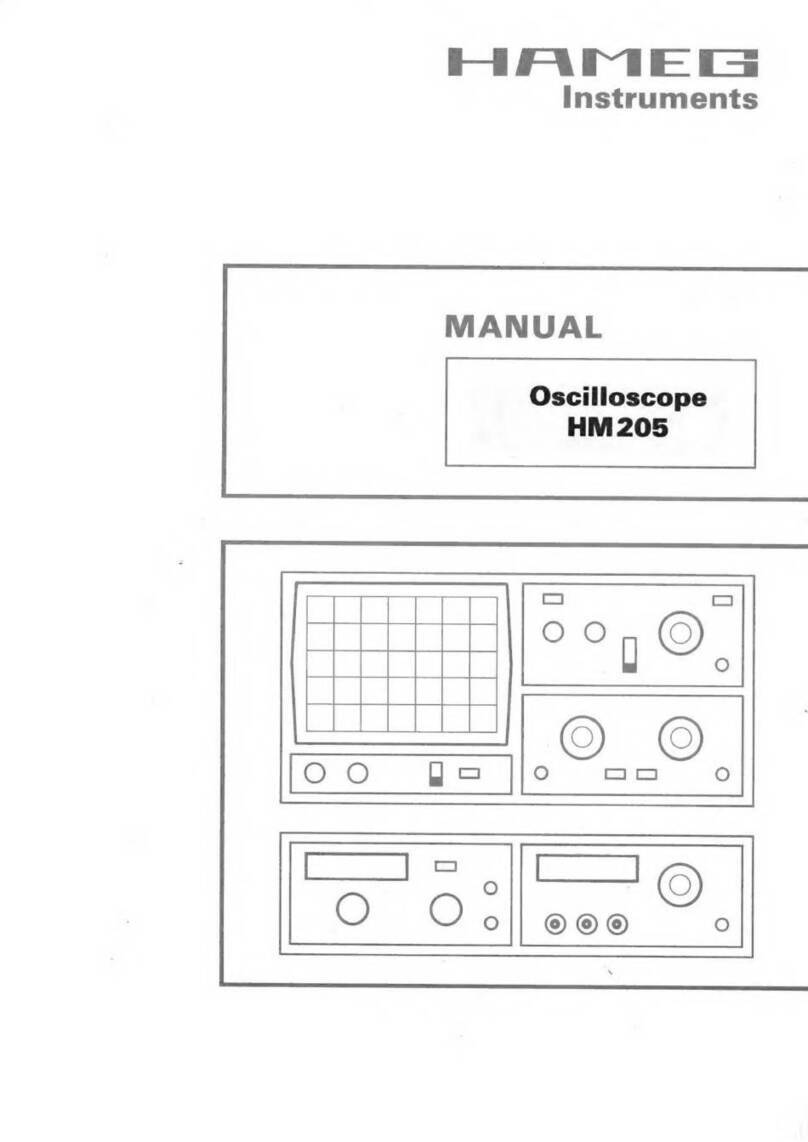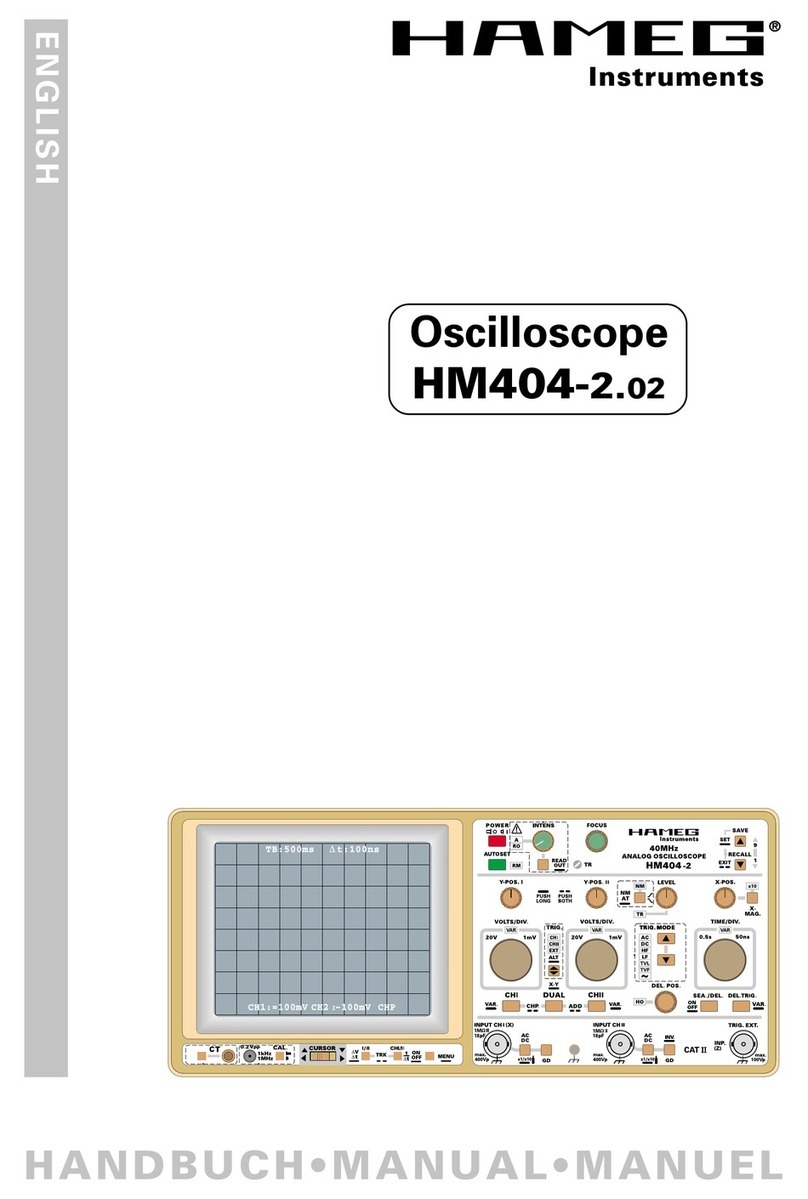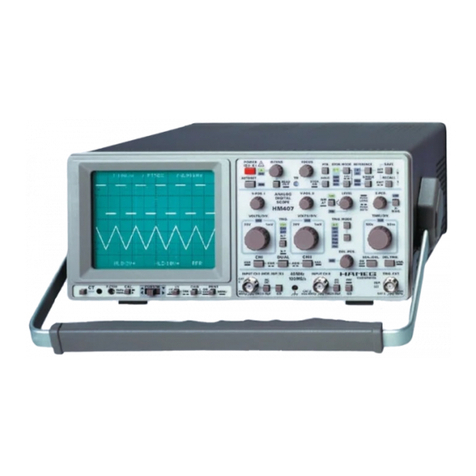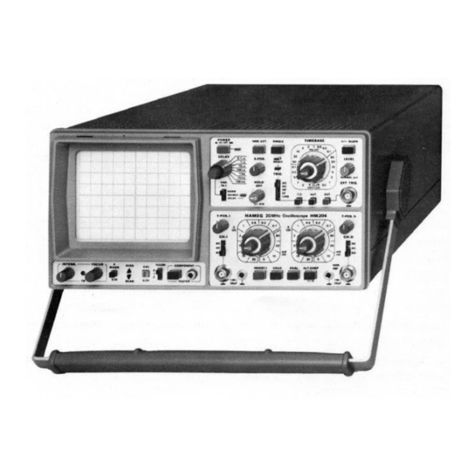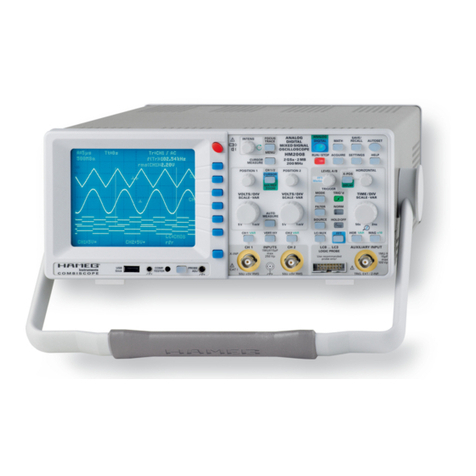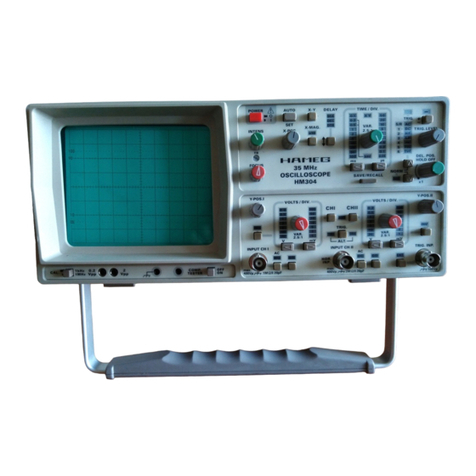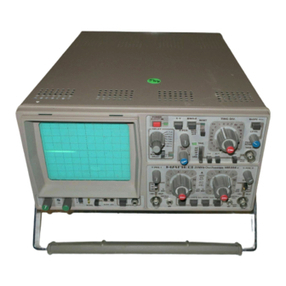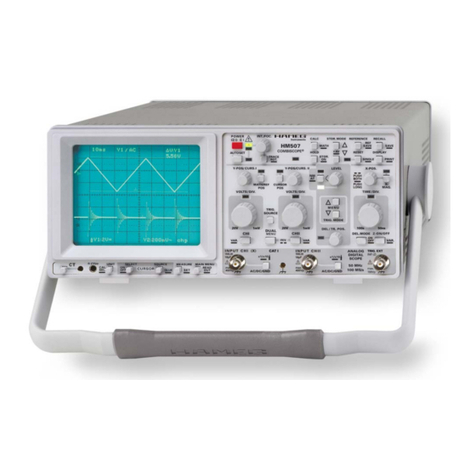
11
Subject to change without notice
HZ22 will only dissipate a maximum of 2Watts. This power
is reached with 10Vrms or at 28.3Vpp with sine signal. If a
x10 or x100 attenuator probe is used, no termination is
necessary. In this case, the connecting cable is matched
directly to the high impedance input of the oscilloscope. When
using attenuators probes, even high internal impedance
sources are only slightly loaded (approx. 10MΩII 12pF or
100MΩII 5pF with HZ53). Therefore, if the voltage loss due
to the attenuation of the probe can be compensated by a
higher amplitude setting, the probe should always be used.
The series impedance of the probe provides a certain amount
of protection for the input of the vertical amplifier. Because
of their separate manufacture, all attenuator probes are only
partially compensated, therefore accurate compensation must
be performed on the oscilloscope (see Probe compensation).
Standard attenuator probes on the oscilloscope normally
reduce its bandwidth and increase the rise time. In all cases
where the oscilloscope bandwidth must be fully utilized (e.g.
for pulses with steep edges) we strongly advise using the
probes HZ51 (x10) HZ52 (x10 HF) and HZ54 (x1 and x10).
This can save the purchase of an oscilloscope with larger
bandwidth.
The probes mentioned have a HF-calibration in addition to
low frequency calibration adjustment. Thus a group delay
correction to the upper limit frequency of the oscilloscope is
possible with the aid of an 1MHz calibrator, e.g. HZ60.
In fact the bandwidth and rise time of the oscilloscope are
not noticeably changed with these probe types and the
waveform reproduction fidelity can even be improved because
the probe can be matched to the oscilloscopes individual pulse
response.
If a x10 or x100 attenuator probe is used, DC input
coupling must always be used at voltages above
400V. With AC coupling of low frequency signals, the
attenuation is no longer independent of frequency,
pulses can show pulse tilts. Direct voltages are
suppressed but load the oscilloscope input coupling
capacitor concerned. Its voltage rating is max. 400 V
(DC + peak AC). DC input coupling is therefore of quite
special importance with a x100 attenuation probe
which usually has a voltage rating of max. 1200 V
(DC + peak AC). A capacitor of corresponding
capacitance and voltage rating may be connected in
series with the attenuator probe input for blocking
DC voltage (e.g. for hum voltage measurement).
With all attenuator probes, the maximum AC input voltage
must be derated with frequency usually above 20kHz.
Therefore the derating curve of the attenuator probe type
concerned must be taken into account.
The selection of the ground point on the test object is
important when displaying small signal voltages. It should
always be as close as possible to the measuring point. If this
is not done, serious signal distortion may result from spurious
currents through the ground leads or chassis parts. The
ground leads on attenuator probes are also particularly critical.
They should be as short and thick as possible. When the
attenuator probe is connected to a BNC-socket, a BNC-adapter,
should be used. In this way ground and matching problems
are eliminated. Hum or interference appearing in the measuring
circuit (especially when a small deflection coefficient is used)
is possibly caused by multiple grounding because equalizing
currents can flow in the shielding of the test cables (voltage
drop between the protective conductor connections, caused
by external equipment connected to the mains/line, e.g. signal
generators with interference protection capacitors).
Controls and Readout
The following description assumes that the instrument is not
set to “COMPONENT TESTER”mode.
If the instrument is switched on, all important settings are
displayed in the readout. The LED’s located on the front panel
assist operation and indicate additional information. Incorrect
operation and the electrical end positions of control knobs
are indicated by a warning beep.
Except for the power pushbutton (POWER), the calibrator
frequency pushbutton (CAL. 1kHz/1MHz), the focus control
(FOCUS) and the trace rotation control (TR) all other controls
are electronically selected. All other functions and their settings
can therefore be remote controlled and stored. Some controls
are only operative in storage mode or have different functions
in analog operation. See “STORAGE MODE ONLY”.
The front panel is subdivided into sections.
On the top, immediately to the right of the CRT screen,
the following controls and LED indicators are placed:
(1) POWER - Pushbutton and symbols for ON (I) and OFF
(O).
After the oscilloscope is switched on, all LEDs lit and an
automated instrument test is performed. During this
time the HAMEG logo and the software version are
displayed on the screen. After the internal test is
completed successfully, the overlay is switched off and
the normal operation mode is present. Then the last
used settings become activated and one LED indicates
the ON condition.
Some mode functions can be modified (SETUP) and/or
automated adjustment procedures (CALIBRATE) can be
called if the “MAIN MENU”is present. To enter this
menu the AUTO SET pushbutton must be pressed
constantly when the HAMEG logo is displayed until
“MAIN MENU”becomes visible. For further information
please note “MENU”.
(2) AUTO SET - Briefly depressing this pushbutton results
in an automatic signal related instrument setting (please
note “AUTO SET”), if the signal frequency and height
are suited for automatic triggering (AT). In Yt mode the
actual channel operating conditions (CH I, CH II or DUAL)
remain unchanged, whereas the time base is auto-
matically set to Atime base mode.
In case of XY or CT (Component Tester) operation, the
instrument is set to the last used Yt mode setting.
Automatic CURSOR supported voltage measurement
If CURSOR voltage measurement is present, the
CURSOR lines are automatically set to the positive and
negative peak value of the signal. The accuracy of this
function depends on the signal frequency and is also
influenced by the signal‘s pulse duty factor. If the signal
height is insufficient, the CURSOR lines do not change.
In DUAL mode the CURSOR lines are related to the
signal which is used for internal triggering.
Controls and Readout
